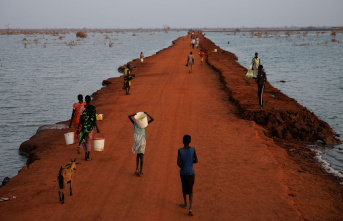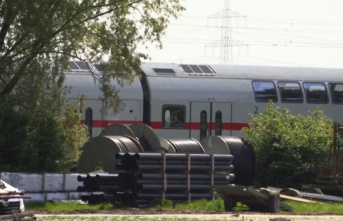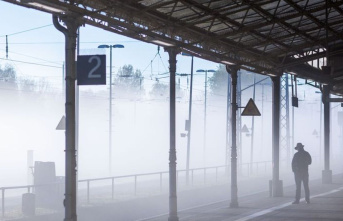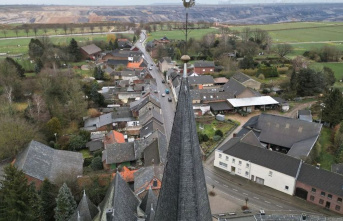In view of the often low snow cover in the Alps and the lack of rain in February, according to experts, massive drought is imminent. Not only the Rhine area suffers from drought. In France, Switzerland, Italy and parts of Austria there is currently much less snow than usual for many years, said meteorologist Klaus Haslinger from Geosphere Austria.
In Italy, the environmental organization Legambiente is sounding the alarm and warning that 53 percent less snow has fallen in the Alps there in recent months than the long-term average. The problem is not only the lack of snow, but also the lack of rain. In the Po basin, Italy's largest river, rainfall has fallen by 61 percent. In France, after several weeks of practically no rain, a second drought summer in a row is already being feared.
Blocking high pressure areas over western Europe, which push rain fronts away, are responsible for the low precipitation. It is not the first time that such weather conditions have resulted in extremely dry years, said Haslinger. Even 60 years ago it had rained very little for years because of a certain temperature distribution over land and sea. "At that time the level of the Danube fell to a record low," said the meteorologist. There is evidence that global warming could favor these temperature patterns.
"If the spring weather is similar to 2022, the drought will become much worse," warns the agricultural meteorologist at the University of Natural Resources and Life Sciences in Vienna, Josef Eitzinger. It is becoming apparent that the rivers will transport much less meltwater. "This means that the spring peak, which would also be important for replenishing groundwater, is missing." In France, according to current data from the national water monitoring system, out of 422 groundwater areas observed, 125 are already at a very low level, 120 at a low level and 97 at a moderately low level.
A lack of water is also affecting Venice, but it is less the result of the drought in northern Italy and the lack of rainfall than the recent high-pressure weather conditions, the tides and the associated low sea level. Because of the water level, many gondolas in the lagoon city are in the mud, smaller canals are no longer navigable. At low tide, a water level of more than 65 centimeters below the normal level was last measured.
Meanwhile, northern Italy is suffering from prolonged drought. According to the newspaper La Repubblica, after February without rain in Italy's "Food Valley", there is a risk of a 40 percent drop in national food production. No one can remember a worse drought there. According to press reports, Lake Maggiore is only 38 percent full, and Lake Como is no better. But the drought is also making itself felt further south in Italy. The capital's newspaper "Il Messaggero" reported that the water level on the Tiber in Rome had already dropped by 1.50 meters.
"Today's snow deficit is the drought next summer and autumn," said Manuela Brunner, Head of Hydrology and Climate Impacts in Mountain Regions at the WSL Institute for Snow and Avalanche Research SLF in Davos. The effects have increased significantly over the decades. In a study she found that the number of droughts caused by snow melt deficits was 15 percent higher in the period 1994 to 2017 than in the years 1970 to 1993. She assumes that the trend will continue because the rise in the snow line. This reduces the amount of water reserves stored in the snow.
In Germany, the meteorologists reported again that the winter was too warm. It was the twelfth winter in a row that was too warm. "Climate change is not letting up," said Uwe Kirsche from the German Weather Service (DWD). The average temperature was therefore 2.9 degrees and thus 2.7 degrees above the value of the internationally valid reference period from 1961 to 1990.
Watch the video: Transport costs on the Rhine are rising sharply due to low water.
And what about the rainfall? Overall, this year's winter months were slightly too dry, as reported by the DWD. The weather service does not record how much snow has fallen in the past three months. But one can say with certainty that there was a lack of snow, said DWD meteorologist Andreas Friedrich. "A winter that is too mild alone does not make climate change. But the twelfth winter that is too warm in a row does," explained Peter Hoffmann from the Potsdam Institute for Climate Impact Research.
"The crests of the low mountain ranges, which were previously considered snow-sure, are increasingly confronted with a lack of snow due to mild weather conditions," said the scientist. This development not only poses existential challenges for winter tourism operators, but also for natural water cycles.
"The Alps are one of the 'skyscraper areas' of Europe," says hydrogeologist Johannes Barth from the Friedrich-Alexander University of Erlangen-Nuremberg. "It is a region with the highest precipitation rates based on experience, because here the clouds are simply slowed down and rain down locally." The Alps could store less water in the groundwater compared to the lowlands. Rather, there are seasonal water reservoirs in the form of snow and ice.
Because of record low levels in groundwater south of Vienna, many farmers would have to adjust to restrictions on irrigation of the fields, says Eitzinger. The level of the ecologically particularly valuable Lake Neusiedl on the border with Hungary - it is mainly fed by rainwater - is lower than ever.











